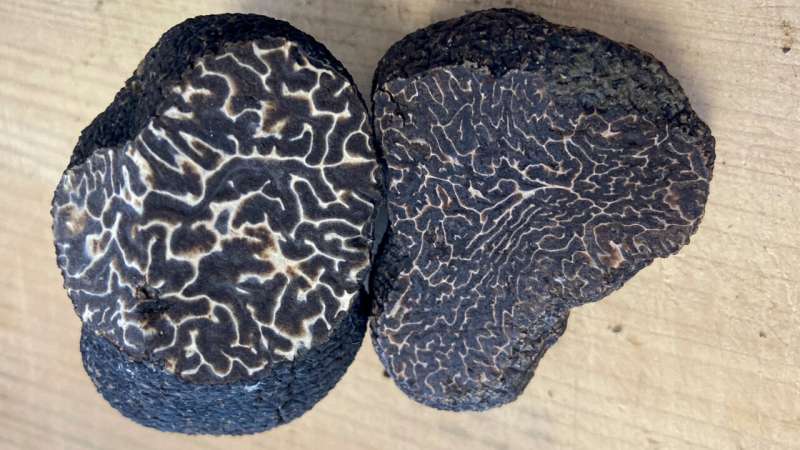This article has been reviewed according to Science X's editorial process and policies. Editors have highlighted the following attributes while ensuring the content's credibility:
fact-checked
trusted source
proofread
Some black truffles grown in eastern US may be less valuable lookalike species, study finds

Some truffle producers in the eastern U.S. intending to grow European black truffles (Tuber melanosporum) are also accidentally cultivating winter truffles (Tuber brumale), a related species that looks nearly identical but sells at a lower price, according to a new study from truffle researchers at the University of Florida and Michigan State University.
The findings are published in the journal Mycorrhiza.
In the U.S. and around the globe, European black truffles are produced commercially in truffle orchards, which contain trees whose roots have been intentionally colonized by the spores of the desired truffle species, a process called inoculation.
The researchers say the truffle orchards in their study likely planted trees that had been inoculated at least partially with winter truffle spores, not those of the more coveted European black truffle, which sell for hundreds of dollars per pound and are a hallmark of haute cuisine.
Working in collaboration with North American truffle farmers, the researchers analyzed specimens from 10 anonymous truffle orchards across six states in the eastern U.S. All but one of the specimens analyzed was a winter truffle. These specimens were sent for analysis after truffle collectors identified them as unusual.
"Our findings suggest that other truffle producers in the eastern U.S. may also be facing this issue. Genetic testing of spores used for inoculation and seedlings to be planted could help growers ensure they will produce the intended species down the line," said Ben Lemmond, first author of the study and a doctoral student studying plant pathology in the UF/IFAS College of Agricultural and Life Sciences.
In fact, European black truffles and winter truffles look so similar that the researchers used genetic testing to identify the specimens in the study.
The winter truffle, or Tuber brumale, has the same black, textured exterior and white-veined interior of the European black truffle, Tuber melanosporum. While both are sold commercially, they differ in price and culinary properties.
"The owners of the truffle orchards in the study reached out to us because they were finding truffles in their orchards they suspected were not European black truffles, and we confirmed this through DNA barcode sequencing," said Matthew Smith, senior author of the study and an associate professor in the UF/IFAS department of plant pathology.
"It's up to the orchard owners to decide what they do next. They may take extra steps to sort the black truffles from the winter truffles," explained Smith, who is also the curator of the UF Fungal Herbarium.
"The only way to get rid of an unwanted truffle species that's already established in the soil is to remove the trees, at which point you'd be starting the orchard from scratch. Even then, the spores from the winter truffle may potentially remain in the soil," Smith added.
Lemmond notes that while winter truffles may not have the cachet of European black truffles, there is still a market for them. Accurately identifying the species of truffles sold to chefs and consumers is especially important now that there is a new truffle species from Europe that is known to be present in North America.
"It is important for people to know that there are more than just 'black truffles' and 'white truffles' in the world. There are more than a dozen species of commercially harvested truffles, and as our study shows, even two truffles that may appear similar at first glance may be two species with completely different culinary properties," Lemmond said.
The study's authors say they are grateful to the truffle growers and collectors who provided the specimens, as they help the scientific community better understand the biodiversity of truffles in North America, much of which is still unknown.
"We feel fortunate to have a strong working relationship with North American truffle growers and the burgeoning truffle industry in the US. As this research demonstrates, there is tremendous value in working together, which provides opportunities for meaningful citizen science and training of students. Further, these results underscore the importance of quality control and verification of truffle inoculated seedlings prior to planting, which will benefit individual farmers and the whole truffle industry," said Greg Bonito, one of the study's co-authors and an associate professor in the department of plant, soil and microbial sciences at Michigan State University.
Alassane Sow, an undergraduate researcher at Michigan State University, also co-authored the study.
More information: Benjamin Lemmond et al, Accidental cultivation of the European truffle Tuber brumale in North American truffle orchards, Mycorrhiza (2023). DOI: 10.1007/s00572-023-01114-8
Provided by University of Florida





















